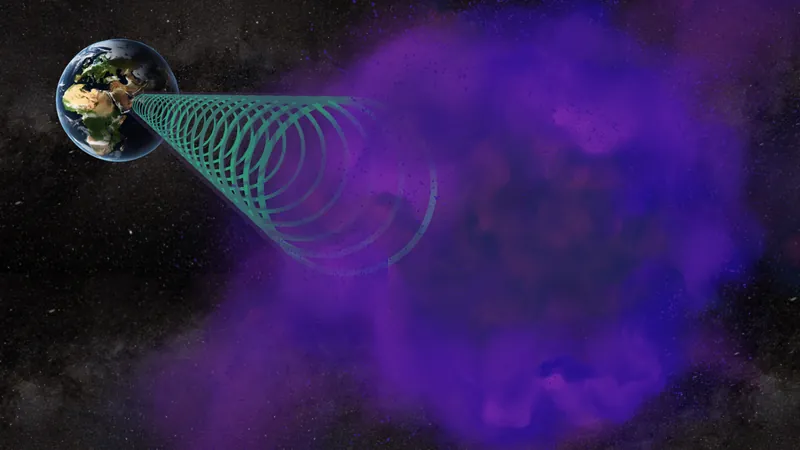
Breakthrough in Dark Matter Detection: Scientists Unveil 'Cosmic Radio'
2025-04-21
Author: Emma
Unlocking the Secrets of Dark Matter
Dark matter, which constitutes an astounding 85% of the universe's total matter, remains one of the most perplexing enigmas in science. Despite extensive research, its true nature still eludes us, with one promising candidate—the elusive axion—proposed by physicists long ago.
A Revolutionary Tool for Discovery
In a remarkable breakthrough, a global team from King’s College London, Harvard University, and UC Berkeley has now developed a detector referred to as a "cosmic radio." This innovative device captures potential dark matter signals using specially engineered quantum materials, heralding a new era in the search for these hidden particles.
The New Axion-Like Particle
Published in a recent issue of Nature, this groundbreaking study details the first-ever detection of a particle resembling the theoretical axion, known as the Dynamical Axion Quasiparticle (DAQ). This achievement brings researchers closer to identifying real cosmic axions, offering potential solutions to age-old mysteries about dark matter and fundamental particle physics.
Why Are Axions So Intriguing?
Originally theorized to solve problems in quantum chromodynamics, axions help explain certain unexpected symmetries in subatomic interactions. They are believed to contribute to the gravitational effects we observe in galaxies, yet until now, they have remained elusive and primarily theoretical.
Building the 'Cosmic Car Radio'
David Marsh, a physicist at King’s College London, likens their detector to a "cosmic car radio" that tunes into the frequencies of the galaxy to search for axion signals. Having developed the underlying technology, the challenge now lies in scaling it up for practical use.
Finding Axions on Earth
The research team turned to advanced quantum materials to mimic the axion's properties, utilizing an ultrathin crystal made from manganese bismuth telluride. This material, just a few atoms thick, played a crucial role in identifying a particle reminiscent of the theoretical axion through subtle rhythmic vibrations.
Unraveling Quantum Mysteries
Scientists previously struggled to detect DAQs due to weak signals and the difficulty of stimulating magnons, which are responsible for these discoveries. However, by selecting the right magnetic fluctuations, they have opened the door to broader explorations that could reshape our understanding of quantum physics.
A Quantum Future
The implications of this research extend beyond dark matter detection. The team plans to scale their technology to probe actual axions traveling through space, anticipating the creation of a more sensitive crystalline detector capable of scanning a wide range of electromagnetic frequencies.
Towards a Milestone Discovery
Marsh's team aims to have a fully operational axion detector within five years, followed by nearly a decade of frequency exploration. Their ultimate ambition is to directly detect dark matter axions, an event comparable in significance to the discovery of the Higgs boson.
Beyond Dark Matter: Quantum Innovations Await
The mechanisms discovered in DAQs may also pave the way for advancements in quantum technologies, leading to novel electronic devices and enhancing our grasp of phenomena such as superconductivity. The interplay between magnons and quantum fields creates fertile ground for innovation and application.
A Bright Horizon for Dark Matter Enthusiasts
As the research community buzzes with excitement over the potential of the "cosmic radio," the attention toward axions parallels the fervor leading up to the Higgs boson discovery. The clear demonstration of DAQs marks a crucial step toward unveiling the universe's secrets, promising that we might soon tune into the hidden signals of dark matter that shape our cosmos.









 Brasil (PT)
Brasil (PT)
 Canada (EN)
Canada (EN)
 Chile (ES)
Chile (ES)
 Česko (CS)
Česko (CS)
 대한민국 (KO)
대한민국 (KO)
 España (ES)
España (ES)
 France (FR)
France (FR)
 Hong Kong (EN)
Hong Kong (EN)
 Italia (IT)
Italia (IT)
 日本 (JA)
日本 (JA)
 Magyarország (HU)
Magyarország (HU)
 Norge (NO)
Norge (NO)
 Polska (PL)
Polska (PL)
 Schweiz (DE)
Schweiz (DE)
 Singapore (EN)
Singapore (EN)
 Sverige (SV)
Sverige (SV)
 Suomi (FI)
Suomi (FI)
 Türkiye (TR)
Türkiye (TR)
 الإمارات العربية المتحدة (AR)
الإمارات العربية المتحدة (AR)